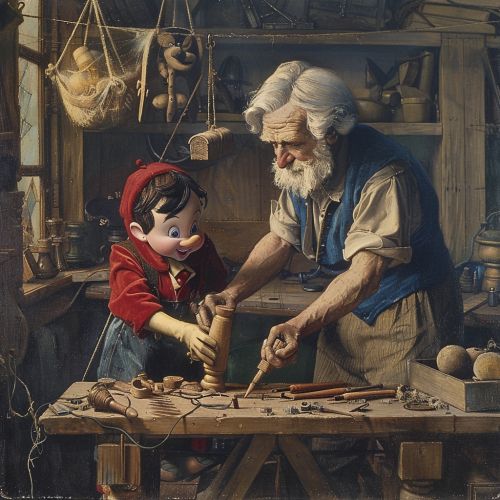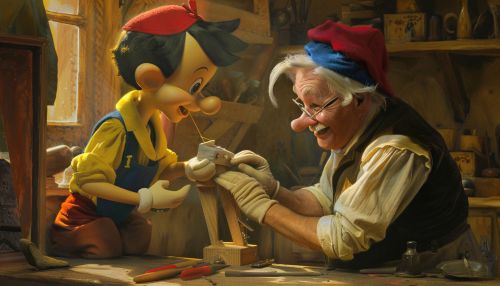The Adventures of Pinocchio: Difference between revisions
(Created page with "== Overview == '''''The Adventures of Pinocchio''''' is a novel for children by Italian author Carlo Collodi. Originally serialized in the ''Giornale per i bambini'' (Children's Magazine) between 1881 and 1882, it was published as a book in 1883. The story chronicles the adventures of Pinocchio, a wooden puppet who dreams of becoming a real boy. The novel is a seminal work in children's literature and has been translated into over 300 languages. == Plot Summary == The n...") |
No edit summary |
||
| Line 74: | Line 74: | ||
Artists have been inspired by ''The Adventures of Pinocchio'' to create paintings, sculptures, and other visual works. The story's rich imagery and moral lessons continue to resonate with audiences. | Artists have been inspired by ''The Adventures of Pinocchio'' to create paintings, sculptures, and other visual works. The story's rich imagery and moral lessons continue to resonate with audiences. | ||
[[Image:Detail-92773.jpg|thumb|center|Pinocchio and Geppetto in a workshop, with Geppetto working on a wooden puppet.|class=only_on_mobile]] | |||
[[Image:Detail-92774.jpg|thumb|center|Pinocchio and Geppetto in a workshop, with Geppetto working on a wooden puppet.|class=only_on_desktop]] | |||
== See Also == | == See Also == | ||
Latest revision as of 02:51, 21 June 2024
Overview
The Adventures of Pinocchio is a novel for children by Italian author Carlo Collodi. Originally serialized in the Giornale per i bambini (Children's Magazine) between 1881 and 1882, it was published as a book in 1883. The story chronicles the adventures of Pinocchio, a wooden puppet who dreams of becoming a real boy. The novel is a seminal work in children's literature and has been translated into over 300 languages.
Plot Summary
The narrative begins with a poor carpenter named Geppetto who carves a wooden puppet named Pinocchio. To Geppetto's astonishment, Pinocchio comes to life. Despite Geppetto's efforts to raise him as a good boy, Pinocchio is mischievous and often finds himself in trouble.
The Creation of Pinocchio
Geppetto carves Pinocchio from a magical piece of wood given to him by his friend, Master Antonio. Upon completion, Pinocchio begins to talk and move, much to Geppetto's amazement. Geppetto decides to send Pinocchio to school, selling his only coat to buy a schoolbook.
Early Misadventures
Pinocchio's journey to school is fraught with distractions. He sells his schoolbook to buy a ticket to the Great Marionette Theatre. Here, he meets Mangiafuoco, the puppet master, who initially plans to use Pinocchio as firewood but later spares him and gives him five gold coins to take home to Geppetto.
The Fox and the Cat
On his way home, Pinocchio encounters a fox and a cat who trick him into planting his coins in the Field of Miracles, promising that they will grow into a tree laden with gold. Pinocchio falls for the ruse and loses his money.
The Blue Fairy
Pinocchio meets the Blue Fairy, who acts as his guardian angel throughout the story. She helps him out of various predicaments and encourages him to be good. Despite her guidance, Pinocchio continues to make poor choices, leading to a series of misadventures.
Transformation and Redemption
After numerous trials, including being turned into a donkey and nearly being used as a drum skin, Pinocchio finally learns the value of hard work and honesty. His transformation is complete when he saves Geppetto from a giant shark. The Blue Fairy rewards him by turning him into a real boy.
Themes
The Adventures of Pinocchio explores several themes, including the importance of education, the consequences of disobedience, and the value of redemption. The story is a moral tale that emphasizes the virtues of honesty, hard work, and familial love.
Education
One of the central themes is the importance of education. Pinocchio's journey is marked by his struggle to attend school and learn. His misadventures often stem from his neglect of his studies, underscoring the value of education in personal development.
Disobedience and Consequences
Pinocchio's disobedience leads to a series of unfortunate events. His encounters with deceitful characters like the Fox and the Cat serve as cautionary tales about the consequences of gullibility and disobedience.
Redemption
The theme of redemption is prevalent throughout the novel. Despite his numerous mistakes, Pinocchio is given multiple opportunities to redeem himself. His ultimate transformation into a real boy symbolizes the possibility of redemption through good deeds and personal growth.
Characters
The novel features a rich cast of characters, each contributing to Pinocchio's journey.
Pinocchio
Pinocchio is the protagonist, a wooden puppet who dreams of becoming a real boy. His character is marked by curiosity, naivety, and a penchant for getting into trouble.
Geppetto
Geppetto is Pinocchio's creator and father figure. He is a kind and loving carpenter who desires nothing more than to see Pinocchio grow into a good boy.
The Blue Fairy
The Blue Fairy acts as Pinocchio's guardian angel. She provides guidance and assistance, helping him navigate the challenges he faces.
The Fox and the Cat
These two characters are con artists who deceive Pinocchio into parting with his money. They represent the dangers of trusting unscrupulous individuals.
Mangiafuoco
Mangiafuoco is the puppet master who initially plans to use Pinocchio as firewood but later shows compassion by giving him gold coins.
Literary Analysis
The Adventures of Pinocchio is a complex work that has been the subject of extensive literary analysis. Scholars have examined its narrative structure, character development, and thematic elements.
Narrative Structure
The novel is episodic, with each chapter presenting a new adventure or challenge for Pinocchio. This structure allows for a wide range of moral lessons to be imparted.
Character Development
Pinocchio's character evolves significantly throughout the story. His transformation from a mischievous puppet to a responsible boy is central to the narrative. This development is mirrored by the changes in his physical form, culminating in his becoming a real boy.
Thematic Elements
The novel's themes are interwoven with its plot and character arcs. The importance of education, the consequences of disobedience, and the possibility of redemption are explored through Pinocchio's experiences.
Cultural Impact
The Adventures of Pinocchio has had a profound impact on popular culture. The story has been adapted into numerous films, television series, and stage productions. It has also inspired various works of literature and art.
Adaptations
One of the most famous adaptations is Walt Disney's 1940 animated film Pinocchio. This version has become a cultural touchstone, although it differs significantly from the original novel in tone and content.
Influence on Literature
The novel has influenced a wide range of literary works, from children's books to adult fiction. Its themes and characters have been referenced and reinterpreted in various contexts.
Artistic Representations
Artists have been inspired by The Adventures of Pinocchio to create paintings, sculptures, and other visual works. The story's rich imagery and moral lessons continue to resonate with audiences.


